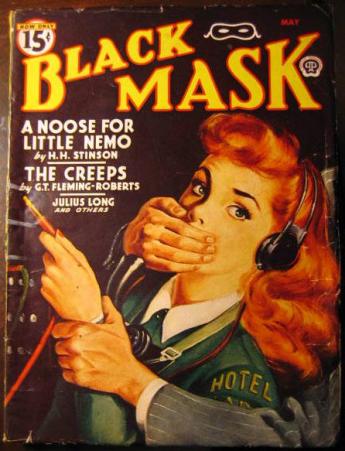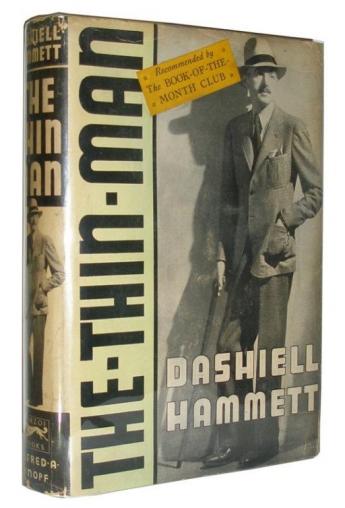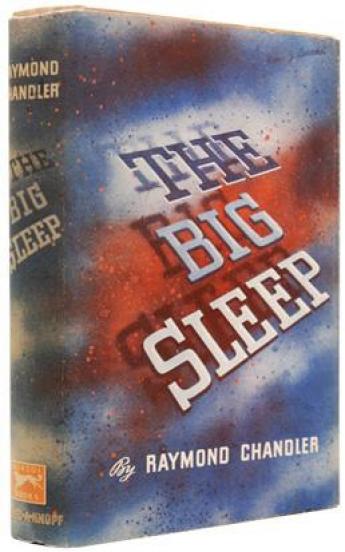Hard-Boiled Detective Fiction and The Private Library

By L. D. Mitchell
One of the most popular components of a private library is the mystery genre, which comprises a vast array of sub-genres such as detective fiction. The genesis of the detective fiction sub-genre may be traced to a short story penned by Edgar Allan Poe in 1841 titled The Murders in the Rue Morgue. All the elements of what we today recognize as the essential characteristics of the sub-genre are found in this short story: a brutal murder; baffled police; an independent investigator that solves the case through superior intelligence, humbling the police in the process.
This formula was put to use in countless hack novels and short stories over the succeeding decades, especially in cheap mass entertainment such as dime novels and yellowbacks. Only occasionally did the sub-genre receive the attention of writers as gifted as Poe. One thinks of Wilkie Collins' The Woman in White (1852) ) or, perhaps, of Charles Dickens' The Mystery of Edwin Drood (1870).
This all changed with the debut of Arthur Conan Doyle's Sherlock Holmes in A Study In Scarlet. "The world's greatest detective" was followed a mere two decades later by what fans now term The Golden Age of Detective Fiction, marked by the rise of authors like Agatha Christie, Dorothy Sayers and others.
But this same period also saw the rise of a much darker strain of detective fiction: a sub-genre within the sub-genre, if you will. Instead of focusing on plot, setting and ingenuity to solve baffling cases, this sub-genre instead focused on brute force and an uncanny ability to survive against all odds. Its first-person narrator precluded the deductive surprises associated with traditional detective fiction. Thus it was that the very year that the Golden Age of Detective Fiction may properly be said to begin (with the publication of Agatha Christie's The Mysterious Affair at Styles in 1920), so too began the rise of hard-boiled detective fiction. The incubator was one of the most important pulp fiction magazines of all time. Appropriately enough, it was called The Black Mask....
Few people building a private library of hard-boiled detective fiction probably are aware that the pulp magazine that most heavily influenced this genre's major tropes, The Black Mask, was co-founded by two of 20th century America's most influential critics and editors, H. L. Mencken and George Jean Nathan.
Think of just about any defining characteristic of hard-boiled detective fiction and it's very likely that that characteristic first appeared in a story in The Black Mask:
• hero has tough attitude: cool, cocky, flippant
• hero is usually private investigator working alone
• violence is second nature to hero
• hero is ambivalent towards police
• hero is usually strapped for cash
• a femme fatale usually is involved in the plot
• the landscape is almost always urban and gritty
• hero drinks heavily but usually remains sober enough to fight bad guys
The Black Mask probably reached the peak of its influence during the decade 1926-1936, when its short stories began to increasingly reflect the harsh realities of life in urban America during that period.
Two writers during this period became especially associated with the hard-boiled detective fiction appearing in The Black Mask: Dashiell Hammett and Raymond Chandler....
Dashiell Hammett, whom the New York Times once called the "the dean of the... 'hard-boiled' school of detective fiction," no doubt penned many of his short stories and novels under the influence of his experiences working for the Pinkerton Detective Agency from 1915-1921. His fictional characters Sam Spade, Nick and Nora Charles, and the Continental Op are among the most enduring ever created in this genre.
In 1931 Hammett embarked on a 30-year affair with soon-to-be famous playwright Lillian Hellman. Three years later (1934), he penned his last novel (The Thin Man) and spent the rest of his life engaged in left-wing activism (also a favorite cause of Hellman's). Because both refused to cooperate with the House Un-American Activities Committee in the early 1950s, they were both (like many other artists of the period) blacklisted.
Raymond Chandler, who created the fictional character Philip Marlowe, probably had an even greater influence on the stylistic development of hard-boiled detective fiction than Hammett. Chandler had begun his writing career as a poet and essayist (he once characterized this period as "Grade B Georgian," referring to his earliest literary influences). His first short story, Blackmailers Don't Shoot, was published in the influential pulp magazine Black Mask, the same magazine in which Hammett had first introduced the Continental Op.
Chandler penned seven complete novels and partially completed another (Poodle Springs, which was completed by Robert Parker in 1989). Most of these eventually were turned into films. He created in most of these novels particularly evocative (if fictional) portraits of Los Angeles. Many critics believe these bittersweet portraits may have been influenced by Chandler's long bouts with clinical depression.
Among Dashiell Hammett's and Raymond Chandler's descendants are a few writers who are noteworthy for creating enduring fictional characters of their own.
Mickey Spillane, for example, is well-known for his fictional character Mike Hammer (first introduced in I, the Jury). Sexist and unremittingly violent, so popular are Spillane's Mike Hammer titles that at one point (1980) Spillane was responsible for seven of the top fifteen all-time bestselling fiction titles in America.
Another noted writer in this genre is Robert B. Parker, creator of the fictional character Spenser (first introduced in The Godwulf Manuscript). Whereas Chandler (and his literary descendant, Walter Mosley) was noted for setting much of his fiction in Los Angeles, Parker--who holds a Ph.D. in English literature from Boston University - is noted for setting much of his fiction in his alma mater's hometown. Parker is almost as well known for his westerns as he is for his hard-boiled detective fiction.
Another literary descendant of Hammett and Chandler is Sue Grafton, creator of the fictional female character Kinsey Milhone (introduced in Grafton's well-knownalphabet series, the first of which was A is for Alibi). Although her books have been published in over two dozen languages, Grafton - who spent fifteen years writing screenplays before penning her first alphabet title - has consistently refused to sell television or film rights for this series.
A final notable literary descendant of Hammett and Chandler is Sara Paretsky, creator of the fictional female character V. I. Warshawski (first introduced in Indemnity Only). Warshawski is no stranger to sex or strong drink, although Paretsky has crafted this character much more subtly than Spillane crafted Mike Hammer.
ILAB presents Part 1 to Part 4 of L.D. Mitchell’s series Hard-Boiled Detective Fiction and The Private Library. For many years L.D. Mitchell's blog The Private Library showed collectors that it is possible to build a collection without the benefit of much money. He published numerous articles on every imaginable subject of book collecting, he wrote about the most beautiful, the most important, the most common, the most attractive, the most unusual, the most interesting, the most extraordinary, the most amazing ... books one could read, buy, collect and simply enjoy. The Private Library has become an irreplaceable resource for all booklovers. Since April 2012, it is a static archive. L. D. Mitchell will no longer post new original content. ILAB is very grateful that he has given permission to publish some of his best articles and collecting tips from The Private Library on the ILAB website.



